- Electronic Signature
- Questions & Answers
- Your 2020 guide to electronic signatures
- Your 2020 guide to electronic signatures
- What is an electronic signature? Learn the ABC’s to avoid confusion
- What are other methods of electronic authentication and how are they related to eSignatures?
- Awareness of an eSignature’s legal standing
- What industries use electronic signatures today?
- How is eSignature technology deployed across different platforms and operating systems?
- How do you choose the right eSignature solution for your business?
- A brief eSignature market overview
- Why are electronic signatures so important?
Your 2020 guide to electronic signatures
Wet signatures have been the primary method for defining the identity of an individual for centuries. But with this method came opportunities for forgery and theft. Skilled hands, criminal intentions, and a bit of practice opened the door to perfectly duplicating someone’s signature. Can you imagine how shocked you would be to discover your signature on a check or contract you’ve never seen?
Since the new millennia, electronic signature technology has proven to be a tremendous technological innovation. As of 2020, electronic signatures continue to gain popularity and market share worldwide, and this trend won’t be slowing down anytime soon.
Electronic signatures are easier to track for legal accountability, and thus more secure. Most importantly, they carry the same legal equivalence as handwritten signatures. As a result, as much as 81% of business users consider eSignatures the most essential component of their daily legal and security operations.
The reason for such widespread usage of electronic signature technology is obvious: most users are either «digital immigrants» or «digital natives.» They’re used to solving their selling, purchasing, and eSigning needs digitally. And inevitably, they consider paper-based document management a waste of time and money.
Minutes vs. days — here’s the difference between an automated, eSignature based workflow and an old fashioned one with the same number of documents and participants involved.
Of course, cases still arise where an e signature might be rejected. However, this mainly depends on your electronic signature vendor and whether it complies with the required legal standards. Read on to find out everything you need to know about electronic signatures, such as their validity, practical usage, and much more.
What is an electronic signature? Learn the ABC’s to avoid confusion
First of all, let’s clarify that this guide focuses on the electronic signature — an image of your handwritten signature on a Word or PDF document. Electronic signatures look similar to those written with a pen and are mainly used for identity verification.
Technically speaking, an electronic signature is a process that indicates the acceptance of a document or record. It’s a single-factor authorization that verifies a signer’s identity with proof of signing achieved via an audit trail embedded within each digital page.
For example, if you have a delivery and a courier asks you to sign using their iPad, the image you’ll draw is your electronic signature. Capturing your handwritten signature with a camera and attaching it to an outgoing email is also considered an electronic signature.
In contrast, a digital signature doesn’t have this visual component. Instead, it’s a unique key that looks like a combination of numbers and is, in fact, an encrypted protocol.
A digital signature verifies that someone with your private signing key has viewed a document and authorized it. Unlike an electronic signature, it is used to authenticate a user’s access or specific action. In everyday life, we deal with digital signatures when conducting payments and banking operations.
To sum up, an electronic signature is a symbol attached to a document that is used by the individual who intends to sign it, whereas a digital signature simply guarantees that a document is authentic.
What are other methods of electronic authentication and how are they related to eSignatures?
- Click-to-sign signatures
A click-to-sign electronic signature is a simple way of signing documents with a single mouse click. Click-to-sign eSignatures include tick boxes, e-squiggles, scanned images, and typed names. In this e signature category, there is no cryptographic protection for a document. And since click-to-sign eSignatures can be easily copied and pasted from one document to another, there are legal conditions to be aware of if you decide to use this method.
For example, a signer must first confirm their consent to do business electronically. That’s why the click-to-sign electronic signature is impossible without an auditable trail of data that attributes it to a particular individual. Accordingly, the signer’s data must be directly associated with the document.
Without an audit trail function, these types of eSignatures may be considered insufficient if called upon as evidence to indicate who signed a document and if that document is adequately protected from subsequent change.
- Biometric signatures
Biometric electronic signatures involve verification or encryption via fingerprint, retina, iris, or voice. All of these methods are growing in popularity because of their ability to ensure digital security. Biometric eSignatures may seem ideal for identity verification and ensuring the integrity of documents during and after the signing process. However, they are not as safe as you might think.
Just like any lock can be picked, any biometric scanner can be hacked using the so-called masterprint. These are custom-made fingerprints that contain all the standard features found on anyone’s fingers.
Hackers use masterprints to hack into devices that use sub-par scanning. While proper scanners will block a masterprint, a less-powerful scanner found in a mobile phone may not be as precise with its checks. As such, a masterprint is an effective way for cybercriminals to access devices that aren’t vigilant with their scans.
There is yet another aspect to biometric eSignatures that may arise as a potential security risk. Keep in mind that since they are harder to fake, they’re also harder to restore. For instance, you can quickly create a new password if someone obtains yours, but you cannot generate a new face if your Apple Face ID gets hacked.
- Blockchain document signing
Initially used in cryptocurrencies, blockchain technology is now being implemented in more mainstream industries. Blockchain eSigning uses the concept of a hash, which is somewhat similar to a fingerprint. Every time a block is added to the chain, a hash is generated for it. Tampering with any block causes the hash address to change. As a result, all blocks containing the previous hash become invalid.
When a document is signed using this method, a hash is generated for the original version of a document. Authorized parties can verify that their copies of a document are legitimate by matching their hash with that of the original version stored in the blockchain.
Blockchain is capable of saving an accurate time stamp/date and identifying the document signer. Therefore, blockchain enables multiple parties to sign documents online via a legally-binding and secure process. However, it most certainly won’t be useful for situations where signers wish to remain anonymous.
Both straightforward and sophisticated types of electronic signatures each have their share of customers.
You most certainly wouldn’t use a click-to-sign electronic signature to certify a multi-million dollar deal and, accordingly, wouldn’t use blockchain signing when you have a fridge or microwave delivered.
Awareness of an eSignature’s legal standing
«Are electronic signatures legally binding?» remains the most frequently asked question among those who have not yet migrated to e signature.
Simply put, yes, electronic signatures are valid and enforceable in nearly every country around the world. Even developing countries are beginning to establish eSignature legislation. Thanks to the Uniform Electronic Transactions Act (UETA) and The Electronic Signatures in Global and National Commerce Act (ESIGN Act), electronic signatures have the same legal status as traditional wet ink signatures in the U.S.
Despite existing legislation, you might need to provide additional legal standing to your eSignature. A situation may come up where multiple witnesses or a notary are required. And that’s exactly why the real question should be: «What makes an electronic signature legally binding?»
- Both parties consent to using an electronic signature. Just as with traditional wet ink signatures, electronic signatures are only valid when a user demonstrates clear intent to sign. For example, industry-leading electronic signature platforms such as airSlate SignNow, are equipped with the Decline Signature Request option that verifies a user’s intent to eSign a document.
- The process of eSignature creation is recorded. The circumstances under which a document is signed can indicate to whom an electronic signature is attributed. Precise attribution is achieved with a detailed audit trail that contains extensive information for every detail of a transaction. Without an audit log, a person can claim that they never signed a document, and there would be no legal evidence to disprove that claim. The information in the audit log includes emails and notifications from signers, a signer’s consent to eSign, user authentication, documents viewed by signers, the e signature a signer creates, cancellations, opt-outs, completed transactions, and so on.
- Records of electronic signatures are retained and made available for accurate reproduction. The ESIGN Act ensures the validity of electronic signature records only if they accurately reflect the agreement and can be reproduced as required. When choosing a solution, make sure your electronic signature software allows you to download copies of any signed document.
Along with reliable eSigning, it’s important to have your data protected from malware threats, hacking attacks, and identity theft. By combining advanced threat protection, multi-factor authentication, and comprehensive audit trails, airSlate SignNow has created a reliable and secure way to sign documents online.
The factors mentioned above will help you choose a legally-binding electronic signature software that suits your needs. Be aware that although systems for security and compliance for electronic signatures may be in place, an electronically signed contract will still face the same scrutiny in a court of law as would its paper counterpart.
What industries use electronic signatures today?
Using modern-day eSignature solutions in old-school areas of business can provide the desired boost needed to speed up administrative processes and reduce operational costs.
-
Financial Services. There are many different ways to use an electronic signature in finance. In the U.S., eSignatures are frequently added to credit/loan forms and mortgages. Also, since 2018, it’s possible to legally notarize documents online.
eSignatures make it easy, quick, and simple to implement global security and the necessary compliance your financial institution needs. With an electronic signature solution, document flows are automated, transactions are quicker, costs are lower, and clients are satisfied.
-
Government. Many local, state and federal governments choose e signature solutions to reduce spending on manual document filling and problematic paper-based processes. An eSignature tool is an effective way for governments to improve responsiveness and engagement.
Thanks to electronic signatures, things like government petitions have changed forever. For example, a 2019 public petition to cancel the United Kingdom’s Brexit deadline collected millions of signatures in just a few months
-
Healthcare. Healthcare providers use electronic signatures to make the switch from inefficient, paper-based work environments to efficient digital environments. Without eSignatures, the future goals of healthcare, long-distance treatment, virtual hospitals, and medical e-commerce are tough to achieve.
For hospitals, reducing the time needed to get signatures from doctors, patients, and insurers is vital. Using eSignatures to shorten or skip specific steps in a typical workflow means better productivity. And since most electronic signature vendors are HIPAA compliant, healthcare workers can maintain full client security and confidentiality — a crucial security measure for any modern business.
-
Education. Daily routines involving paper are massive wastes of time. And time is money. Printing, mailing, signing, scanning, faxing — all these processes can be easily replaced with a single solution: electronic signature. There’s a variety of features that can make teachers’ lives easier. For example, creating a team for collaborating on timesheets, schedules, teacher reports, etc., can be done in seconds.
Electronic signatures lead to improved processes and help increase student-institution relations by streamlining communication and document management. Better communication between students, teachers, administrators, and governmental organizations leads to better grant research and operational organization.
-
Insurance. The business of insurance brokering is among the most paper-centric industries out there. E signature technology provides two critical benefits for insurers: saved time and cut costs. Traditionally, an insurer has to spend an hour collecting handwritten signatures for a contract and NDA, compared to 5 minutes with digital tools. Doing things the traditional way can lead to costs up to $20 per document!
By adopting a simplified system for obtaining signed documents, 80% of expenses related to insurance would disappear.
-
Real Estate. What’s the end goal for any real estate deal? The sale! However, it takes a lot of paperwork to get there. The process is littered with docs from meeting your agent, creating initial agreements, starting the negotiation, all the way to signing paperwork with the bank and title agency.
eSignatures allows a user to certify a document from virtually anywhere, making mobility one of the most significant e signature benefits for real estate and title agents, mortgage brokers, and of course the clients themselves. A 10-minute delay in getting a signed offer to a seller could potentially cost your buyer the deal. In contrast, with eSignatures, once the user approves the document, it’s instantly sent to the recipient, reducing the bottlenecks that often occur with traditional mailing, faxing, and printing.
Whether you’re working in real estate, healthcare or tech, eSignatures have become the gold standard for efficiency and simplicity. Using new tools in old-school areas of business can provide the desired boost needed to speed up administrative processes and reduce operational costs.
How is eSignature technology deployed across different platforms and operating systems?
- MS Windows
Windows users have Microsoft Word. And Word remains one of the world’s leading document processing softwares used by businesses and individuals to create and manage documents. To save time and avoid dealing with third-party apps, many Windows users choose to add electronic signatures to documents directly in Word.
Although Word has a built-in feature that allows users to create electronic signatures and add them to documents, its e signature toolset has limited functionality. That limitation makes it a somewhat outdated choice for most individuals and organizations.
Check out how to apply an electronic signature in Microsoft Word:
- Place the cursor exactly where you’d like to add your signature.
- Go to the Insert tab, click Signature List, then Microsoft Office Signature Line.
- Fill in the required fields in the Signature Setup window.
- Select and upload an image of a signature that you have stored on your computer or type your name directly in the box. If you’re on mobile, draw your signature using your finger or stylus.
At first glance, there’s nothing wrong with eSigning documents in Word. Issues come later with more complex eSignature workflows that involve more than one signer. Imagine a situation where you have to send a document to every flow participant manually.
Upon receiving the document, they have to open it in Word, follow the above-mentioned steps to add their own signature, save the document and send it back to the sender. This method is prone to human error and drastically slows down the signing process.
While being a powerful document management tool that is popular with millions of users worldwide, Word wasn’t designed to be an electronic signature solution. It can still be used for adding eSignatures, but its faults in speed and complexity outweigh its benefits.
If all you need to do is add images at the end of documents or use basic e signature functionality, it’ll probably work. But if you’re looking for a more diverse set of features, an advanced electronic signature solution is the way to go.
- macOS
Mac users are luckier than Windows users when it comes to built-in eSignature tools. Preview, which comes with macOS by default, has integrated features for signing online.
Thanks to MacBook’s and iMac’s excellent trackpad, you can quickly draw your signature and apply it in Preview. Apple is constantly improving its tools for online document management.
Learn how to add a signature in Preview:
- Open a PDF document in Preview and click the Show Markup Toolbar icon.
- Click on the Signature icon, then on Create Signature to create a signature by dragging your finger over the trackpad or by scanning a handwritten version of your signature with your webcam.
- Save your signature for future use.
- Select your signature from the menu that appears after you click the Signature icon.
- Drag and drop your signature wherever you’d like and then adjust its size.
- Save the document when finished.
Once your e signature is applied, use the dotted area around the image box to resize it. You also can use Preview’s drag-and-drop feature to move the signature box around the document. Every time you save the document, the signature on the page is saved as well.
Despite its convenience, Preview has the same drawbacks as other built-in signing tools. For instance, you most likely won’t use this method for eSignature workflows that involve multiple signers.
- iOS
Sign documents on an iPhone or iPad using Markup in iOS’s Mail. This tool is convenient, but it only works if you want to sign documents in Mail. For example, if you get a PDF document and need to sign it and email it right back, you’ll need to perform the following steps:
- Open the attached PDF and tap the Markup and Reply icon at the bottom right-hand corner of the screen.
- Add your signature by tapping the signature button at the bottom right-hand corner of your screen. If needed, type text and draw on the document.
- Once you tap Done, Mail automatically creates a reply to the email with your signed document attached. It also gives you an option to add a message before sending it.
While this is convenient, it’s also very limiting. If you’re looking for a different way to eSign your document with your iPhone or iPad, you’ll need to download and install an app for electronic signature.
- Android
Traditionally, the process of eSigning documents on Android devices has been quite frustrating. Android devices aren’t equipped with any built-in apps that allow you to create electronic signatures.
The only option here would be to download and install a third-party app. Luckily, there are several apps in the Google Play Store you can use to sign PDFs for free. In the next section, we’ll talk about how to do an electronic signature using a standalone eSignature solution.
- Web app
In a way, each of the methods described above are tricky with limited capabilities only suitable for performing simple tasks. To effectively manage your document-driven processes, you’ll still need an advanced e signature tool regardless of the device and operating system you use. This includes collecting and distributing applications, closing contracts, and even filing taxes.
Let’s see what a basic eSignature workflow looks like within an enterprise-level electronic signature app, such as airSlate SignNow.
- To get started, select a document from your device or the cloud and upload it to airSlate SignNow.
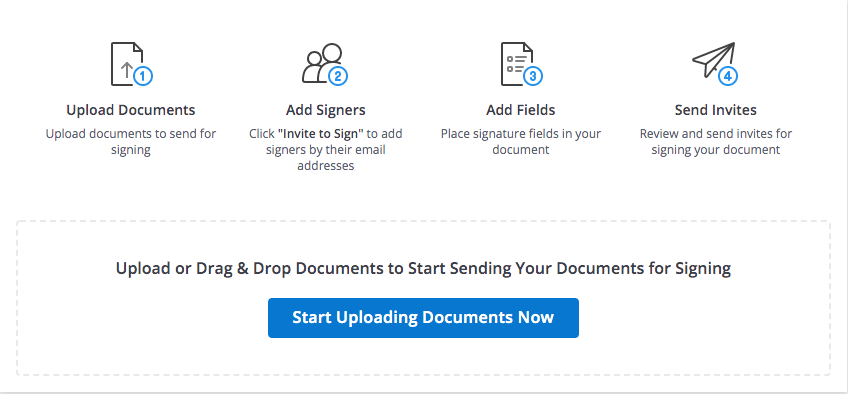
- Edit your document according to your needs before sending it for signing. Add necessary fillable fields (e.g., text, the date/time, dropdowns, checkboxes, eSignature) and assign these fields to your signer(s).
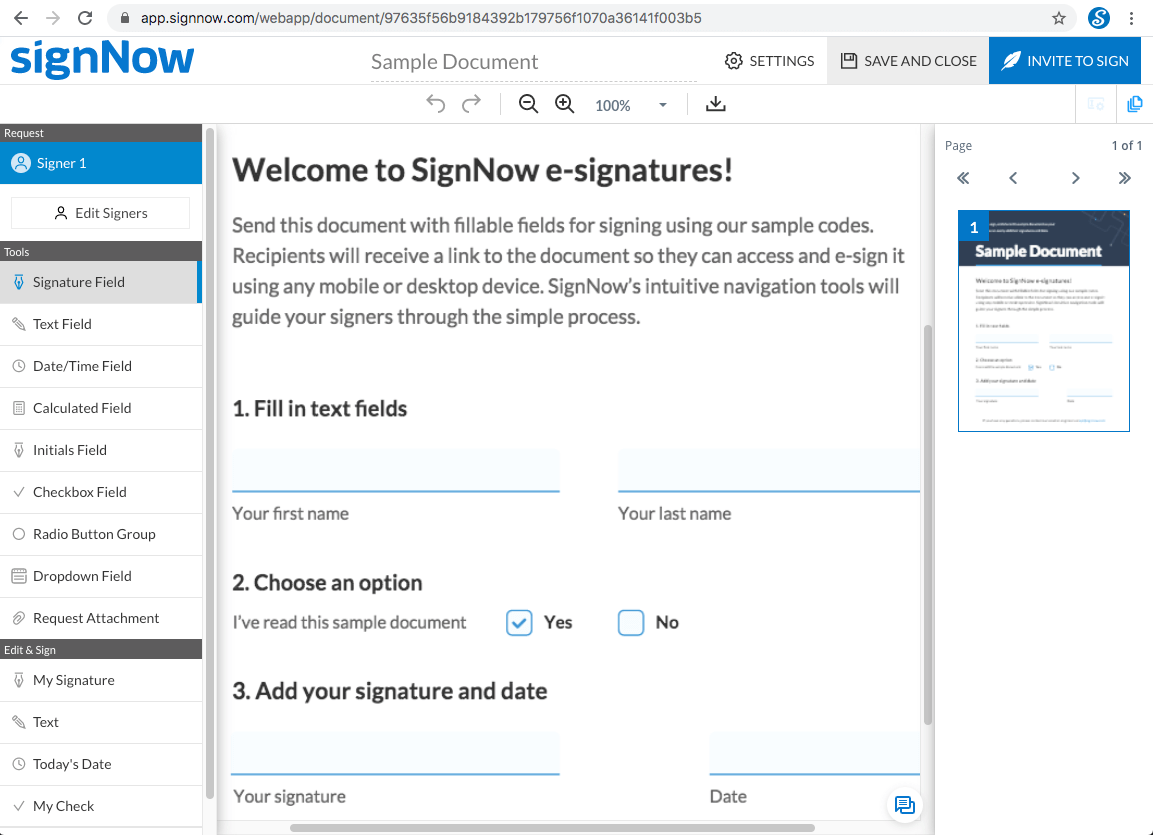
- Click Invite to Sign to send a signature invitation, fill in the signers’ emails, create a customized message, and add a unique signing order.
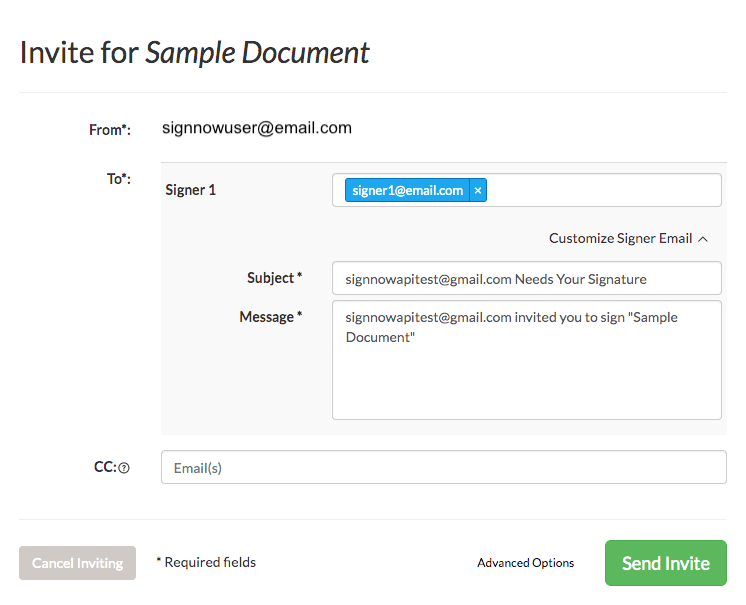
-
Click Advanced options to set advanced signer settings. Request signer authentication to ensure your document cannot be accessed by anyone other than your intended recipient.
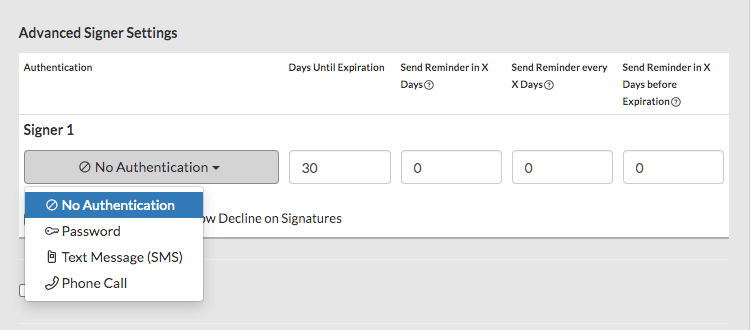
Additionally, you can even request payment from your signer and set up an automatic reminder or expiration date for your invite. Once all the parameters are set, simply click Send invite.
eSigned your documents as a recipient in airSlate SignNow:
- Go to your inbox, open the invitation email and click Sign Document.
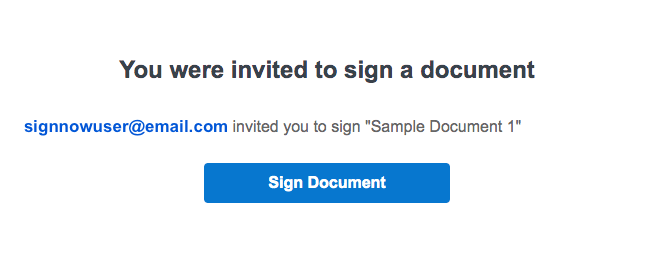
- If the email was sent to you by mistake or if you have any questions, you can contact the sender directly by clicking Contact Sender.

- Fill out the required fields and click the signature field to start signing. Choose whether you want to upload an image of your handwritten signature, draw it using your mouse, trackpad, or finger. Click Sign when ready.
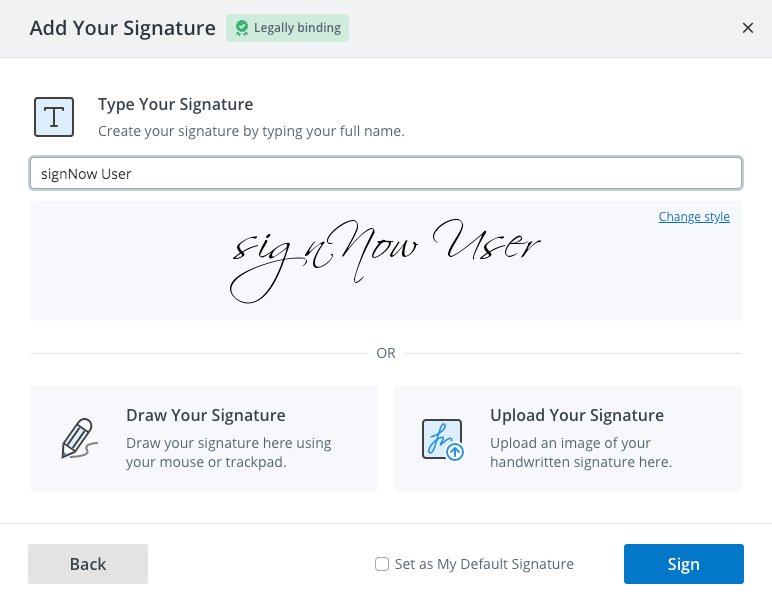
- If you make a mistake or need to change something, just click the signature field again and make a new one. And remember, you can always change your mind and click Decline To Sign.
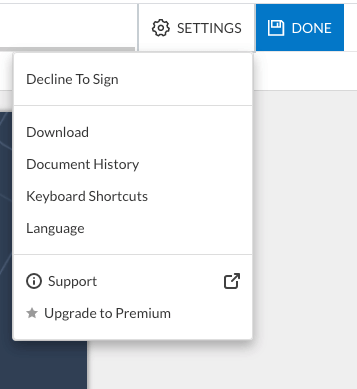
- Click Done to finish. The sender will automatically be notified and receive their signed copy.
Keep in mind that you cannot edit documents once they’re completed. If you view a signed document, you’ll notice there’s no option for editing or updating it. Once you’ve signed a document, you can’t go back and edit your eSignature, add fields, convert it to a template, or generate a new signing link.
In addition to extended eSigning capabilities, airSlate SignNow provides users with an option to track document changes via a powerful Audit Trail and Document History function.

To access your Document History, click More next to the document that you want to track. Then, select History from the dropdown menu. You’ll see a pop-up table with all actions that’ve been taken in the document, alongside timestamps and IP addresses.
- To get started, select a document from your device or the cloud and upload it to airSlate SignNow.
How do you choose the right eSignature solution for your business?
There are many e signature providers out there, but it doesn’t mean they all match your goals and business model. To find the best fit, explore the features each company provides and determine which criteria are essential for your business and which are not.
- What should be taken into account?
- Features. Complex issues require advanced solutions. Need to create a fillable template for a frequently used document? Want your documents to be signed in a specific order or to set roles for each signer? Make sure your electronic signature vendor has all the necessary features BEFORE downloading the app to your device.
- Pricing. Let’s be honest: free apps suck big time in most cases. On the other hand, you shouldn’t have to pay more than you would for a large cup of coffee for your eSignature provider. Choose a payment plan which suits your budget and make sure your vendor is cost effective.
- Integrations. Cleverly using integrations allows you to work faster and impacts your business’s efficiency. If you’re used to working with Dropbox, Word, or Google Drive, you certainly don’t want to waste time adjusting to a new environment. That’s why it’s important to make sure the e signature provider of your choice is equipped with a complete set of integrations.
- Security. An electronic signature is just as legally binding as a handwritten one. Therefore, a high level of protection must be established to keep your data safe. Check whether your eSignature vendor provides its customers with an audit trail and password-protected, eSigning functions.
- What are the qualities of a risk-free eSignature tool?
Quick and intuitive. Avoid time-consuming solutions and downloadable apps. Choose lightweight, browser-based software with an easily navigable interface.
Solid and secure. Choose vendors with enterprise-level confidentiality and privacy standards, such as SOC 2 Type II certification.
Compatible with any device and OS. You should have the ability to eSign documents regardless of the device being used, i.e., Mac, PC, tablet or smartphone.
Easily customizable. Edit documents before signing or sending them to be signed. Add initials, checkboxes, text, date/time fields and dropdown menus. Organize docs by keeping them in their respective folders.
Accessible from anywhere. View and edit documents even while you’re offline. Review the editing history and monitor the signing process.
Still can’t make a decision? Here’s a tip: Sign up for a free trial from a popular e signature provider, test the important features and make sure the software can handle your organization’s specific demands.
A brief eSignature market overview
airSlate SignNow. An award-winning electronic signature solution, airSlate SignNow was ranked the #1 eSignature application for enterprises with a satisfaction score of 9.56 out of 10. First introduced in 2018, it is famous for its simple, mobile-friendly interface and user-driven approach that allows for easy maneuvering through e signature workflows. airSlate SignNow outpaces its competitors in terms of pricing, user support and ease of signature processes.
- Features. airSlate SignNow is mainly known as a comprehensive web app compatible with any device and operating system. It also features fully-functional iOS and Android apps that allow users to edit, collaborate on, and eSign documents even offline. airSlate SignNow’s industry-leading mobile capabilities have also made it the #1 electronic signature app in the App Store. Along with many other things, airSlate SignNow mobile apps enable you to import files from your Photo Library, capture documents using your phone’s camera, and even collect in-person signatures with your iPad in Kiosk Mode.
- Pricing. Pricing charts may be concealing a nasty surprise if you don’t know what to look out for. airSlate SignNow pricing is known for its affordability and transparency. It doesn’t contain any hidden fees or limits on the number of signature requests. While DocuSign’s Business Premium plan will cost you $135 per user per month, airSlate SignNow’s pricing for the same plan is only $15 per user per month. Read more about airSlate SignNow’s pricing here or try it out with no obligations by subscribing to a 7-day free trial.
- Integrations. Technology integrations with airSlate SignNow allow individuals and enterprises to access airSlate SignNow features without leaving their business applications. airSlate SignNow integrates with 21 different programs, including Microsoft Office 365, OneDrive, NetSuite, Oracle, G Suite, Google Drive, Salesforce, Box and many more. These integrations range from CRM to security to electronic document management programs. What’s more, with the airSlate SignNow REST API, you can easily adjust complex e signature workflows with multiple users and roles involved. You don’t even have to contact salespeople to get started: Create your sandbox account and test the airSlate SignNow API for free. See the complete list of airSlate SignNow integrations here.
- Security. airSlate SignNow ensures the highest level of protection for your documents. With airSlate SignNow, your documents are kept on remote SOC 2 compliant servers, meeting all necessary industry standards for security, availability, integrity, privacy and confidentiality. The platform also provides a complete document history featuring all changes made to documents and users who performed them. airSlate SignNow operates in full compliance with the General Data Protection Regulation (GDPR) and supports medical organizations’ compliance with 21 CFR Part 11. At the same time, PCI DSS certification safeguards confidential cardholder data.
Adobe Sign. Being one of the most popular brands on the eSignature market, Adobe Sign is part of the Adobe Document Cloud suite of services. It’s a cloud-based eSignature service that allows users to send, sign and track eSignature processes using a web browser or mobile device.
Adobe Sign can be used based on an individual, small business, or enterprise-level subscription. Services offered by the platform include signing forms with an electronic signature, collecting signatures from multiple users, creating branded forms, receiving email notifications and sending reminders.
- Features. With Adobe Sign, you can eSign documents using both a web app or a standalone iOS/Android app. The platform allows users to send, track and manage eSignature workflows while on the go. You can collect in-person electronic signatures, scan paper documents with your mobile device’s camera and send them for signing.
- Pricing. Adobe Sign features plans for both business users and individuals. Its basic individual plan starts from $9.99 per user per month (if billed annually). There is also no limit on the number of documents you’re allowed to process. While sharing many of the same features, Adobe Sign Business subscription is cheaper than DocuSign’s Business and Business Premium subscriptions.
- Integrations. Adobe Sign is designed to run within Salesforce, Apttus, Workday and other enterprise apps. It integrates with many productivity apps such as Box, Dropbox and Microsoft Dynamics. API tools allow users to integrate Adobe Sign capabilities into their custom apps.
- Security. Adobe Sign is compliant with electronic signature legislation, including the EU eIDAS Regulation and the US ESIGN Act. Recipients have an option to verify the document’s authenticity. Every transaction comes with a complete audit trail featuring all corresponding events and actions, and the platform meets all security and compliance standards. It also provides an identity verification feature that ensures additional protection during the signing process.
PandaDoc. An all-in-one document management and automation software, PandaDoc features eSignatures among other capabilities. The system supports multiple document formats and integrations, allowing users to unite their existing CRM, payment and file storage apps into a single workflow.
- Features. PandaDoc is a mobile-friendly solution, allowing you to eSign your docs on the go from your smartphone or tablet. However, if you’re looking for extra functionality (i.e., document creation, CRM integrations and other workflow capabilities), you will most likely need the PandaDoc web application.
- Pricing. PandaDoc offers Individual, Business, and Enterprise plans, starting from $9 per user per month (billed annually). The interesting thing about PandaDoc’s pricing is that, according to the monthly plan, the user can only manage up to 5 documents every month (or 60 documents per year.) If you want to process an unlimited number of documents, you have to upgrade to a Business subscription.
- Integrations. PandaDoc integrates with many popular CRMs, allowing you to update records automatically and auto-fill documents with data. Also, it easily integrates with payment systems like PayPal and QuickBooks.
- Security. PandaDoc is GDPR compliant and SOC II Type II certified. Document data (metadata, activity, original files, and customer data) is stored in different locations and encrypted when transferred within the system.
eversign. eversign is another solution featured in the G2 Crowd’s Best eSignature Software list. The platform helps individuals and enterprises manage sensitive documents such as contracts and business agreements.
Key features include in-person signing, a web-based document editor, contract management tools and many more. eversign also provides a library of fillable templates for contracts and forms. It allows users to pre-fill any document with text, checkboxes and other elements. On top of that, signers can edit documents on both desktop or mobile devices.
- Features. eversign is optimized for smartphones and tablets. The service allows mobile users to edit documents on the go and access documents from wherever they are. Native iOS and Android mobile apps aren’t available. Instead, eversign automatically detects which device is used and adjusts user preferences accordingly.
- Pricing. Compared to other eSignature solutions, eversign’s pricing policy is quite tricky. The platform doesn’t offer a free trial but grants free access to eversign Lite, a lightweight package which allows one team member to process up to 5 documents plus an additional 3 API documents per month. Apart from that, there are Basic, Professional, Professional Plus and Enterprise plans, starting from $9.99 (if billed yearly). Read more about eversign’s pricing here.
- Integrations. eversign integrates with many third-party services, including Google Docs, Zoho, Dropbox and Salesforce. Signed documents stored in eversign can be scheduled for auto-expire or permanently deleted after they reach a particular deadline.
- Security. eversign is maintained by apilayer, a provider of cloud-based API and Software-as-a-Service (SaaS) brands for developers. It ensures a maximum level of protection for your documents and transaction. The signing process is equipped with an Audit Trail containing a detailed log of all actions related to the document. All data related to a user’s account, including documents and account information, is stored on cloud servers hosted by IBM.
HelloSign. HelloSign is one of the industry’s old-timers. The platform has been providing individuals and teams with a wide range of tools for resolving paperwork bottlenecks through an intuitive, user-friendly signing experience since 2010.
The platform offers security/compliance and custom branding standards at a small business-friendly price. With HelloSign’s flexible workflows, team management, and Google plug-ins, you can fill out and sign documents online at any time.
- Features. In addition to the web-based app, HelloSign has separate mobile apps for mobile devices. Another cool thing about the platform is that it’s heavily integrated with Google. HelloSign offers a Google App for onboarding teams and allows users to use their Gmail credentials to log into the system.
- Pricing. Like eversign, HelloSign provides a free plan with limited capabilities that enables one user to send up to 3 signature requests every month. Other plans (Pro, Business, Enterprise, HelloSign API) allow a certain number of senders to process an unlimited number of documents. These plans start from $13 (billed annually).
- Integrations. HelloSign supports integrations with a number of business apps such as Salesforce, Oracle Content & Experience Cloud, HubSpot CRM, Slack, Eventbrite, and more. HelloSign also integrates with the following cloud storage services: Google Drive, OneDrive, Dropbox, Evernote and Box.
- Security. HelloSign keeps your documents private and secure by utilizing SSL encryption and world-class secure server infrastructure. Each document within HelloSign is encrypted with a unique key. What’s more, each key is encrypted with a regularly changed master key. Even if someone were able to bypass the physical security and access a drive where your data is stored, they wouldn’t be able to decrypt it.
Why are electronic signatures so important?
eSigning in the digital age gives you much more than the ability to put your autograph on a document in the easiest way possible. The full menu of benefits includes things like streamlined project management and fully-automated document workflows.
In 2020, eSignatures are not only about having access to a mind-blowing toolset but also about establishing a sound and rational approach to your business’s development.
It’s up for you to decide whether you’re ready to open doors to new opportunities and direct your business toward the future.

- Your 2020 guide to electronic signatures
- What is an electronic signature? Learn the ABC’s to avoid confusion
- What are other methods of electronic authentication and how are they related to eSignatures?
- Awareness of an eSignature’s legal standing
- What industries use electronic signatures today?
- How is eSignature technology deployed across different platforms and operating systems?
- How do you choose the right eSignature solution for your business?
- A brief eSignature market overview
- Why are electronic signatures so important?
Related questions
Business Cloud
Automate business processes with the ultimate suite of tools that are customizable for any use case.
-
Award-winning eSignature. Approve, deliver, and eSign documents to conduct business anywhere and anytime.
-
End-to-end online PDF editor. Create, edit, and manage PDF documents and forms in the cloud.
-
Online library of 85K+ state-specific legal forms. Find up-to-date legal forms and form packages for any use case in one place.